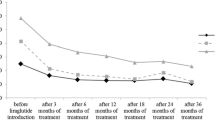Abstract
The GLP-1 receptor agonist Liraglutide is effective in reducing HbA1c in type 2 diabetic (T2D) patients. In addition, treatment with Liraglutide is associated with significant weight loss. In this study, we analyzed the inter-relationships between glycemic and weight effects of Liraglutide treatment in a population of type 2 diabetic outpatients. T2D patients initiating Liraglutide therapy since September 2010 to July 2012 at 3 outpatient clinics were enrolled and followed-up. We collected baseline information about anthropometric data, cardiovascular risk factors, diabetes duration, prevalence of complications and history of anti-diabetic medications. We collected HbA1c and body weight at baseline and every 4 months. A total of 166 patients were included, who were on average 56.6 ± 8.9 (mean ± SD) years old and had a baseline HbA1c of 8.7 ± 1.3 % and BMI 36.3 ± 6.4 kg/m2. Mean follow-up was 9.4 ± 4.2 months (range 4–16). Patients lost on average 1.5 ± 1.3 % HbA1c and 4.0 ± 5.0 kg body weight. Most patients (73.5 %) improved HbA1c and loosed weight. Significant independent determinants of HbA1c drop were baseline HbA1c (r = 0.673; p < 0.001) and previous insulin therapy (r = −0.251; p < 0.001). The only independent determinant of weight loss was baseline BMI (r = 0.429; p < 0.001). Drop in HbA1c was unrelated to baseline BMI or weight loss. Weight loss was unrelated to baseline HbA1c or drop in HbA1c. Glycemic improvement and weight reduction obtained with Liraglutide treatment in T2D patients in a real-world setting are independent and possibly mediated by different mechanisms.



Similar content being viewed by others
References
Inzucchi SE, Bergenstal RM, Buse JB et al (2012) Management of hyperglycaemia in type 2 diabetes: a patient-centered approach. Position statement of the American Diabetes Association (ADA) and the European Association for the Study of Diabetes (EASD). Diabetologia 55:1577–1596
Niswender K, Pi-Sunyer X, Buse J et al (2013) Weight change with liraglutide and comparator therapies: an analysis of seven phase 3 trials from the liraglutide diabetes development programme. Diabetes Obes Metab 15:42–54
Zander M, Madsbad S, Madsen JL, Holst JJ (2002) Effect of 6-week course of glucagon-like peptide 1 on glycaemic control, insulin sensitivity, and beta-cell function in type 2 diabetes: a parallel-group study. Lancet 359:824–830
van Genugten RE, Moller-Goede DL, van Raalte DH, Diamant M (2012) Extra-pancreatic effects of incretin-based therapies: potential benefit for cardiovascular-risk management in type 2 diabetes. Diabetes Obes Metab (in press)
Fadini GP, de Kreutzenberg SV, Gjini R, Avogaro A (2011) The metabolic syndrome influences the response to incretin-based therapies. Acta Diabetol 48:219–225
Drucker DJ (2006) The biology of incretin hormones. Cell Metab 3:153–165
Jelsing J, Vrang N, Hansen G et al (2012) Liraglutide: short-lived effect on gastric emptying—long lasting effects on body weight. Diabetes Obes Metab 14:531–538
Hoyda TD, Smith PM, Ferguson AV (2009) Gastrointestinal hormone actions in the central regulation of energy metabolism: potential sensory roles for the circumventricular organs. Int J Obes (Lond) 33(Suppl 1):S16–S21
Grundy SM, Cleeman JI, Daniels SR et al (2005) Diagnosis and management of the metabolic syndrome: an American Heart Association/National Heart, Lung, and Blood Institute scientific statement. Circulation 112:2735–2752
Buse JB, Rosenstock J, Sesti G et al (2009) Liraglutide once a day versus exenatide twice a day for type 2 diabetes: a 26-week randomised, parallel-group, multinational, open-label trial (LEAD-6). Lancet 374:39–47
Monami M, Dicembrini I, Marchionni N, Rotella CM, Mannucci E (2012) Effects of glucagon-like peptide-1 receptor agonists on body weight: a meta-analysis. Exp Diabetes Res 2012:672658
Garber A, Henry RR, Ratner R et al (2011) Liraglutide, a once-daily human glucagon-like peptide 1 analogue, provides sustained improvements in glycaemic control and weight for 2 years as monotherapy compared with glimepiride in patients with type 2 diabetes. Diabetes Obes Metab 13:348–356
Deacon CF, Mannucci E, Ahren B (2012) Glycaemic efficacy of glucagon-like peptide-1 receptor agonists and dipeptidyl peptidase-4 inhibitors as add-on therapy to metformin in subjects with type 2 diabetes-a review and meta analysis. Diabetes Obes Metab 14:762–767
Chambers AP, Jessen L, Ryan KK et al (2011) Weight-independent changes in blood glucose homeostasis after gastric bypass or vertical sleeve gastrectomy in rats. Gastroenterology 141:950–958
Valderas JP, Irribarra V, Rubio L et al (2011) Effects of sleeve gastrectomy and medical treatment for obesity on glucagon-like peptide 1 levels and glucose homeostasis in non-diabetic subjects. Obes Surg 21:902–909
Conflict of interest
None.
Author information
Authors and Affiliations
Corresponding author
Additional information
Communicated by Massimo Federici.
Rights and permissions
About this article
Cite this article
Fadini, G.P., Simioni, N., Frison, V. et al. Independent glucose and weight-reducing effects of Liraglutide in a real-world population of type 2 diabetic outpatients. Acta Diabetol 50, 943–949 (2013). https://doi.org/10.1007/s00592-013-0489-3
Received:
Accepted:
Published:
Issue Date:
DOI: https://doi.org/10.1007/s00592-013-0489-3




